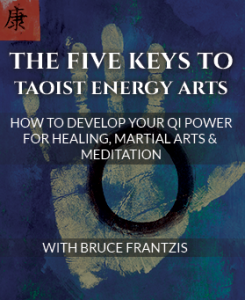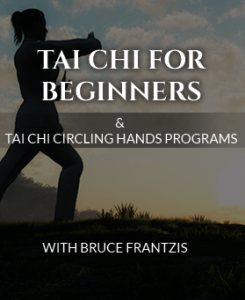The internal martial art of Bagua Zhang and the highest levels of Tai Chi are ultimately based on the sphere. In this video, Senior Instructor Lee Burkins demonstrates bagua using a motion capture monitor.
If you look at a circle, you will see it is two dimensional. This circle effectively moves on one plane. Alternatively, a sphere infinitely combines circles, moving on three primary planes—allowing for movement up, down, forward, back, left and right.
In bagua zhang, anytime you move your arm or leg, take a step or turn your waist, there should always be a sense that you’re not only moving in front of you, but simultaneously to the side of you, and to the back of you.
All these motions of front, back, and side, are a slightly more advanced level of bagua zhang, but are ultimately what you’re aiming for. So when your hand goes forward, something is also happening in back of you, and something is also happening to your left and your right side.
This eventually creates a sphere, which is the strong point of many tai chi styles, such as Wu Style tai chi.
Essential in this spherical motion is keeping your arms and the area between your legs from collapsing, while also paying attention to your thighs and your pelvis, and all the upper parts of your body. Be sure that they are always expanding equally in all directions, and that you become very conscious of what your back is doing, as well as what your ribs and your sides are doing.
In this motion, your arm or your leg is moving on a sphere; going from the edge of the sphere into the center of the sphere, and out to periphery of the sphere again. In and out, in and out. This is very different in many ways than the circular movement found in some larger styles of tai chi, such as Yang style.
Spherical Motion in Bagua ultimately does have to be taught by a teacher because although you might comprehend it intellectually, you must get these movements into your body. It’s a bit like someone explaining how to play a complex piece of music, and attempting to play that piece without sheet music simply based on their explanation. There is more to this motion than can be explained in intellectual terms.
The important thing about all Spherical Motion, which is primary to both Bagua and Tai Chi, is that every motion you do emanates equally in all directions – front, back and sidewards. You won’t feel just one arm moving spherically, rather you will feel both your arms, your legs and every part of your body, emanating in all directions.
As you practice Spherical Motion, it will begin to stretch every part of your body equally. In the commonly practiced circular motion, one part of your body may have a circular feeling such as your arm, however, that may not encompass your legs, it may not encompass your weight.
Even if only your arms and your weight have a spherical sense, this will stretch everything from your spine and your internal organs equally in all directions – forward, back, and sidewards, as well as up and down. It is critical that the pressures from your arm should always be going up, down, forward, back, left, and right.
A radically different and incredibly positive effect is created when all this is combined. However, with this said, it’s usually required that people practice circular motion, because very circular motions must be experienced before spherical ones are possible. For example, spherical motions in Bagua are primarily done by intermediate practitioners and not by beginning practitioners.
If you are practicing Tai Chi or Bagua, the first step is to start to make everything more smooth and circular. Once that is done, the real game begins as you move from the circle to the sphere. The level of experience to pull this off varies and the ways in which you get there can be many, which is why both bagua and tai chi are called ‘arts’ rather than sciences. This is also why they are lifetime practices that get deeper and deeper according to your own level of passion, enthusiasm and commitment.






Thank you Bruce. I do a Yang style Taiji and this gives me something to think about in trying to relate it to my practice.
This is wonderful!
Beyond a certain visual understanding I have to wonder what value these mechanical illustrations provide to an aspiring student? Isn’t it possible for these three-dimensional models to become the last word, especially for the techno-cornocopian? Wouldn’t windswept drapery, the crashing wave or foliated whiplash line provide a far more organic impetus in terms of inspiring the spherical response? Why settle for the formulaic equivalent of “Mannerism” when the wide-world of Nature beckons for a willing pair of eyes to instruct ?